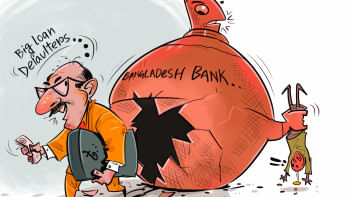Could covenants save our banks from defaulted loans?

A central question regarding Bangladesh's banking sector at present is: how can the number of defaulted loans be reduced? We know that high non-performing loans (NPL) contract credit supply, distort allocation of credit, slow down economic growth, and increase inequality.
As of September 2022, NPLs have soared over Tk 134,000 crores. These bad loans have been driven by lending based on political connections (where corrupt bank directors and select politicians join forces and disregard all rules related to loan disbursement), a general lack of enforceability of banking regulations, and absence of proper internal monitoring systems, which can help identify and reduce common sources of credit risk.
There are some specific sources of risk that a bank must preemptively address. The first set of risks would be inadequate screening of borrowers and selecting projects which are not credit-worthy. The second, and perhaps even bigger, risk is failing to monitor the borrower after the loan is granted. This is because lenders can never perfectly forecast how well the borrower will perform when they agree to the loan contract, and these risks may not always be priced in. For example, the borrower's initial revenue projections may have been overly optimistic or the economy could be hit with a severe recession.
An even bigger point of concern is that a borrower will always want to take more risks than what a lender would prefer. The reason behind this is standard economics.
A borrowing company's top management or owners are typically the equity-holders of the firm. Lenders, like a bank, are the debt-holders. A debt-holder's payoff has no real upside since the maximum income they can ever obtain is the amount of interest plus principal payments on a given loan. Unlike debt-holders, equity-holders always have significant advantages: once debt (and tax) payments are made, the equity-holder has full claim on its firm's remaining income. So naturally, the equity-holder will want to take more risks to achieve a higher return, since no firm owner will ever be satisfied with earning just enough money to meet debt and tax payments.
A simple analogy is to compare the risk attitudes of those who prefer to invest mostly in stocks (equity-holders), versus those who invest more in bonds (debt-holders). The point is that a bank needs a system that prevents the borrower from taking on too much of a risk after the debt is in place.
And this is where loan covenants come in.
A loan covenant is a restriction on the actions a borrower can take once a loan has been granted. It is typically written into the initial loan agreement and its goal is to reduce the aforementioned conflict of interest between borrowers and lenders. If a loan covenant is violated, the lender receives the contractual right, but not the obligation, to punish the borrower in some way. For instance, if a company violates a covenant due to bad management or over-optimistic revenue projections, the bank could reduce credit access for the future, force immediate repayment, reduce loan maturity, refuse to raise credit limit, or raise interest rates on the existing loan.
The intuition for loan covenants is that the expectation of future punishment upon violation could prevent borrowers from taking on a level of risk they cannot handle in the first place.
However, while this all sounds good in theory, what do covenants look like in practice?
One popular covenant is a maximum leverage ratio, which prevents a company's debt-to-earnings ratio from exceeding a predefined threshold in any quarter. Other popular covenants include: 1) restrictions on the total amount of capital expenditure a company can undertake: 2) maintaining minimum liquidity requirements at all times: 3) establishing a maximum amount of dividends that the company's directors can pay themselves; or 4) not taking on new debt while existing debt is still left unpaid.
Covenants have been used extensively in many developed and emerging economies. My own research shows that covenants appear in the vast majority of corporate loans in the United States, and lenders frequently exercise their enforcement rights when a company violates a covenant. For example, many banks restrict borrowers from raising the leverage ratio above 3.5 or 4.0.
But are loan covenants common in Bangladesh?

My conversations with experienced bankers in Bangladesh suggest that loan covenants are quite standard among at least two of our leading foreign commercial banks (FCB). This is not surprising since FCBs typically follow a centrally-approved risk management practice across multiple countries. So it is also a small wonder that the NPL ratios in FCBs are drastically less than what is found in the overall banking sector.
Interestingly, a few top-tier domestic private banks also take covenants quite seriously. However, the vast majority of domestic private banks do not properly enforce covenants. When a borrower violates a covenant, they simply waive the covenant without any enforcement, regardless of whether that leniency was economically or financially justified. Not surprisingly, the same is true for public banks. This lack of enforceability is exactly what encourages borrowing companies to take excessive risks.
Why is the level of enforceability so different across banks operating in the same country? One reason is well known: lending based on political connections.
A second, not necessarily mutually exclusive, explanation is that there are perhaps more banks than necessary. Lower-tier or relatively newer banks might have a desire to maintain client relationships and gain market share. So they display unjustified leniency and, in doing so, misallocate credit. This might be beneficial for a bank in the short-term but creates serious long-term costs for the economy.
Bangladesh Bank (BB) needs to revisit covenant-related practices in the banking sector. As a first step, regulators need to improve data transparency. In particular, an initiative could be undertaken to construct a bank-level database where covenant practice and covenant compliance is recorded on a periodic basis for each loan. BB needs to hold lenders accountable if they fail to act when a borrower violates a covenant, unless the lender provides reasonable arguments in granting leniency towards a company. However, this initiative will not be effective unless BB can exercise its power on corrupt bank directors who would prefer to minimise corporate governance for their own benefit.
If regulators fail to act, Bangladesh will stay stuck in this vicious cycle of rising bad debts and rampant inequality.
Dr Sharjil Haque, Phd is an economist based in Washington DC.

 For all latest news, follow The Daily Star's Google News channel.
For all latest news, follow The Daily Star's Google News channel. 










Comments